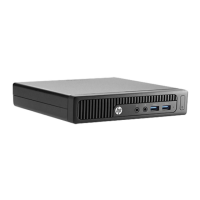
Do you have a question about the HP 260 G1 and is the answer not in the manual?
| Graphics | Intel HD Graphics |
|---|---|
| Processor | Intel Celeron, Pentium, or Core i3/i5 |
| RAM | Up to 16 GB DDR3L-1600 SDRAM |
| Storage | 500GB to 1TB HDD or 128GB to 256GB SSD |
| Operating System | Windows 7, 8, or 10 |
| Form Factor | Mini PC |
| USB Ports | 2 x USB 3.0 |
| Networking | Gigabit Ethernet |
| Chipset | Intel H81 |
| Ports | VGA |
| Optical Drive | DVD-RW |
Identifies and describes the PC's front panel connectors and buttons.
Details the ports and connectors on the rear of the computer.
Lists and illustrates the computer's main internal hardware components.
Shows different types of storage drives and their specifications.
Illustrates various small components like fans, speakers, and antennas.
Explains ESD risks and methods to prevent damage to electronic components.
Instructions for proper operation to prevent overheating and prolong computer life.
Covers general cleaning precautions and specific instructions for the case and keyboard.
Essential considerations for disassembly, assembly, tools, and component handling.
Details information about handling and characteristics of hard drives.
Provides information and warnings regarding the system's coin cell battery.
Outlines essential steps and safety precautions before starting hardware removal.
Details the procedure for removing the computer's access panel.
Step-by-step guide for removing and replacing the computer's hard drive.
Explains memory types, installation, and replacement for SODIMMs.
Provides instructions for safely replacing the system's lithium coin cell battery.
Details the process for removing and replacing the CPU heat sink.
Describes how to remove and replace the computer's system board.
Explains how to replace wireless antennas and transceivers.
Overview of the utility's functions for configuring system settings and defaults.
Covers setting up passwords, security features, and managing system IDs.
Discusses advanced configuration options for bus and device settings.
Solutions for common issues like system lock-ups, incorrect date/time, and performance.
Addresses issues related to hard drive errors, recognition, and performance.
Offers solutions for common monitor and display-related issues.
Helps diagnose and resolve issues caused by applications, drivers, or system files.
Lists and explains numerical codes and text messages during Power-On Self-Test.
Guides on understanding front panel LEDs and audible beeps for diagnostics.
Explains how to clear CMOS and reset passwords using the system board jumper.
Details the process of resetting the system's CMOS to factory defaults.
Explains how to initiate hardware diagnostics from the BIOS or boot menu.
Provides instructions for downloading diagnostic tools onto a USB drive.
Covers creating recovery media and performing system restores for Windows 8/8.1.
Details backup, restore, and recovery procedures specific to Windows 7.
Steps for creating recovery media (USB or discs) for system recovery.
Explains how to perform a full system recovery using recovery images or media.
Lists general specifications and approvals required for power cord sets.
Outlines specific power cord standards and certifications for different countries.
Provides key physical, environmental, and power specifications for the computer.